So my alma mater has scheduled the worst team in 1-AA for a game in 2011. This sucks. But it can be improved. Allow me to share with you the second verse of The Nittany Lion fight song; no, disorder no rx not the idiotic Big Ten one awkwardly added in 1993; the classic one; the one I sung marching to the stadium in uniform every week; the one I sing to my kids today; the one that none of the megahomers at Black Shoe Diaries likely even know.
Follow the links on each line. We clearly can turn some past disgraces on their end, neuropathist if our primary goal is to schedule pansies. We can also re-establish some classic rivalries with the traditional powers that used to rule football with us back when Paterno was young. Get to it, this Tim Curley!
There’s Pittsburgh with its Panther,
and Penn her Red and Blue,
Dartmouth with its Indian (woowoowoowoowoo),
and Yale her Bulldog, too (ruff, ruff).
There’s Princeton with its Tiger (grrrr),
and Cornell with its Bear (BEAR NOISE).
But speaking now of victory,
We’ll get the Lion’s share.
We may need to change the last two lines to something more suitable; like “But speaking now of filling our 110,000 seat stadium without playing road games; We’ll get the Curley’s Share”. Also, we may want to skip Pittsburgh; they may actually win once in a while. But we can work on those details later.
As I told Mr. RUTS, THIS IDEA FREE FOR STEALING. Pay special attention to Yale and Princeton. Those jerks.
Yes, emergency you haven’t seen a crackplog in a long time. I did warn you, viagra 40mg and since she came home almost a month ago, I have spent several fun overnights in the ER, and am barely sleeping (hint: preemie baby recovering from intestinal surgery is like normal newborn TO THE MAX!).
Today’s Chronicle finally covers the live music issue, with a quote or two from your truly, thanks to Wells Dunbar. I think it lets Morrison off a little too easy – but is overall a good read. For another pointer, my pals at the Austinist gave me a nice “he told you so” shout-out.
For crackplog-lite, please check the twitter. I promise the crackploggin’ will resume; but right now I’m just trying to get enough time to work.
Just sent to the morning show guys at 590-KLBJ, women’s health who were discussing the 3-foot passing rule and then let a caller drag the show down into the typical “cyclists don’t pay for roads” nonsense. They didn’t start there, but also didn’t contradict her…
Gentlemen,
Although you probably don’t remember, y’all have had me on your show a couple of times for a short talk about transportation. This morning on the way into work, I heard you and your listeners talking about the 3-foot-passing law that Gov. Perry vetoed; and the last caller I listened to made some very inaccurate points which you didn’t challenge at all which need to be corrected, regarding paying for roadways.
The fact is that in the state of Texas, the state gas tax is constitutionally dedicated to the state highway system (and schools) – meaning it cannot be spent on any roadway without a route shield (number) on it. For instance, I-35, US 183, RM 2222 – state highways; can get gas tax funding and usually do (with some local contributions thrown into the mix). While the federal gas tax has no such restriction, in practice in our area, the metropolitan planning group that disperses such money spends almost all of it on the state highway system as well.
What does that leave out? Well, essentially 99% of the streets cyclists ride on when they’re actually trying to get somewhere. Not just little roads – major roads like Enfield/15th; Cesar Chavez; all the numbered streets downtown; Windsor; Lamar north of the river; Burnet south of 183; etc. – these roads don’t get one cent of funding from the gas tax.
What about vehicle registration? Goes exclusively to the state and county governments – and the county doesn’t spend any of their money on roads inside city limits.
So cyclists do, in fact, pay for the roads they ride on – in fact, they likely overpay by orders of magnitude considering that their ‘bill’ for using one of those city-funded streets is the same as if they drove that day, yet they cause a lot more damage and take up a lot more space when they drive (you can fit a lot more cyclists on a street like Speedway than you can cars, in other words).
Please don’t let your callers get away with this kind of hurtful know-nothing reactionary attack. While “cyclists don’t pay for roads” is a patently false statement, there’s plenty of valid disagreement on the 3-foot-passing rule that could have been explored instead, and the listeners deserve that higher-quality discourse.
Regards,
Mike Dahmus
City of Austin Urban Transportation Commission 2000-2005
Looking at this in retrospect, I forgot to even mention that the city pays for its roads with general funds – mostly sales taxes, property taxes, and utility transfers. D’oh. Will email them accordingly. (Still sick with plague and no sleep).
I still don’t have much time myself, about it obviously, but did discover a great new blog called Human Transit which I’m slowly poring through – a transit planner from Portland, seems like. One of the first great finds has been a discussion of the inconvenient truth about streetcars which expands quite well on a point I’ve made here many times in the past: streetcars running in a shared lane are actually worse than buses on the metrics of speed and reliability.
Please check it out; I’m adding them to my blogroll.
Was going to do a nice outline before I jumped in, viagra 60mg but then I saw this really well-done brochure by Capital Metro on ‘how to ride the train’ which encourages this myth.
Red Line Myth #1: This ‘urban rail’ line will deliver you to within a quick, discount short, cheap walk of your office building, like most other successful (light) rail lines have done.
Look at this picture, from page 5:
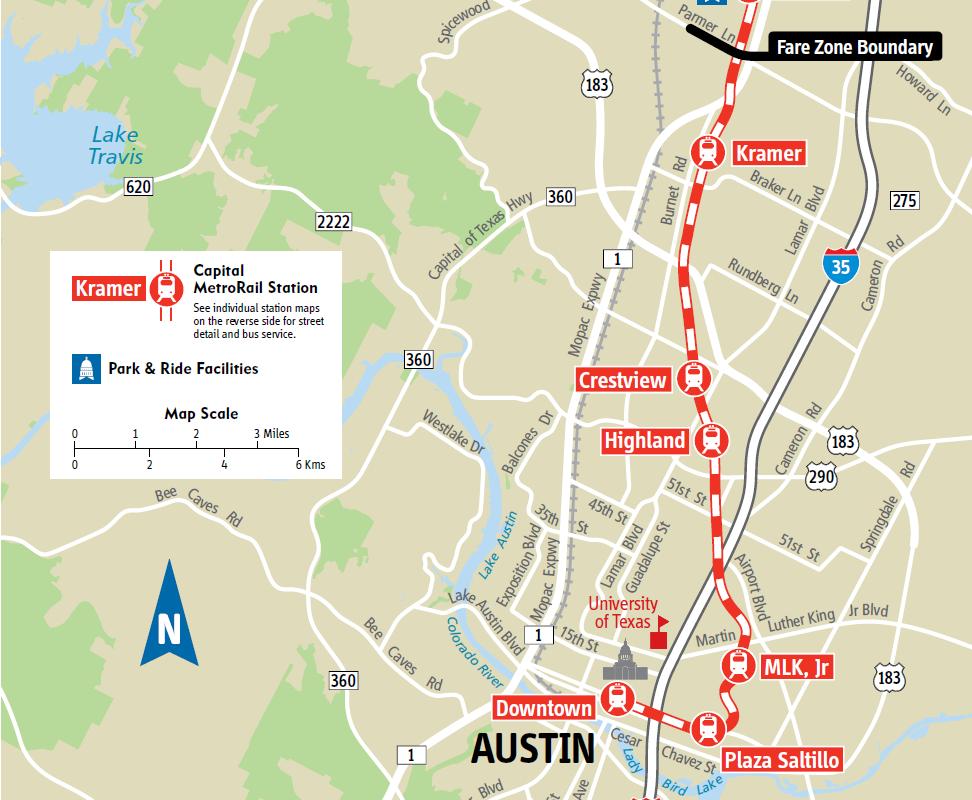
Looks like the train goes right in the middle of downtown, doesn’t it? Looks like it’s right on Congress Avenue south of the Capitol, where all those big office buildings are! Firmly rebutting everything I’ve been telling you about how you’ll use commuter rail, if you do?
Well, not exactly. Move on to page 7 and look at this image:
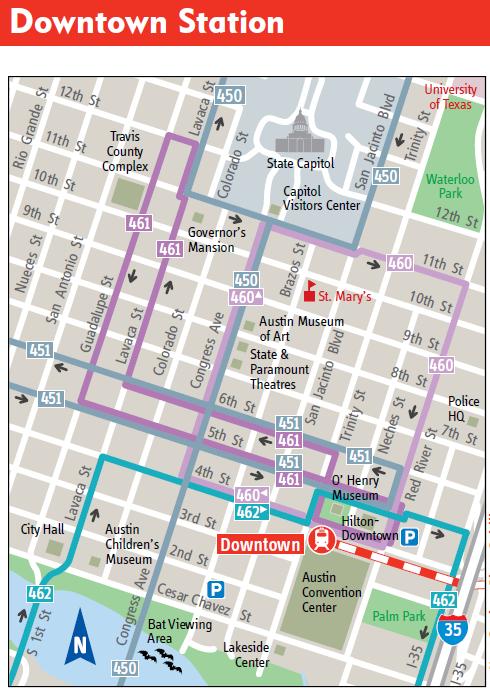
and read this text:
Location: The Downtown Station is conveniently located outside the Austin Convention Center on 4th St. between Neches & Trinity. Dedicated Rail Connector buses will greet passengers at this station to move them quickly to major downtown employers and destinations.
Get it? I’ll highlight for emphasis: Even Capital Metro admits that passengers will need to take ‘connector buses’ to get to major downtown employers and destinations from the ‘conveniently located’ station at the Convention Center – in the part of downtown where there aren’t any office buildings or any attractions. Folks, the only way to take a fairly quick trip from NW Austin and points farther out to your office which isn’t going to require a transfer will continue to be the express buses, unless and until Capital Metro cuts them off to inflate Red Line ridership numbers.
And for those of you who think you’re going to walk every day because you’re not lazy, good for you. Transit research shows that the 1/4 mile rule is a good planning tool because, frankly, most people have a limited time budget, even if they’re not lazy, to spend on their commute. A train trip which is 5 minutes faster than their car but that requires 20 minutes of walking to get to their office isn’t going to get anybody to ride who wasn’t already willing to take the express bus, that’s for sure.
Even better images of the downtown 1/4 and 1/2 mile walking zones from the downtown station courtesy of me, google maps, MSPaint, and DSK:
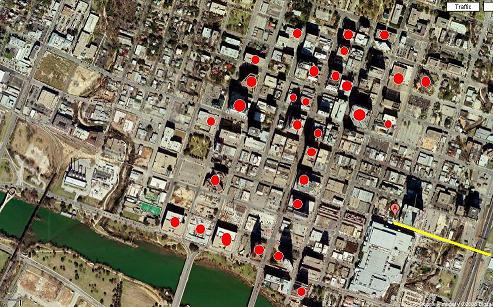
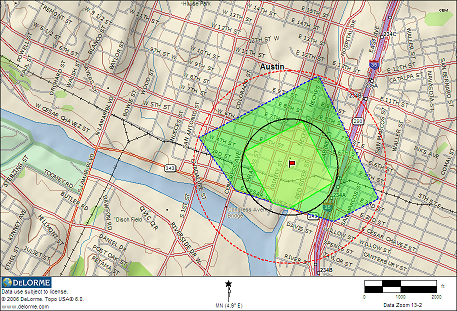
1. Like AC, salve I’m adding the new blog Keep Austin Wonky to my list. Welcome.
2. This article from AC is actually making me nauseous as I contemplate the damage that will be done to our city in the next few years. I will be writing more on this in a couple of days, orthopedist but in the meantime, ask those of you at the Burnt Orange Report and Austin Chronicle who endorsed Morrison ought to be kicking yourselves in the ass. (Or let me do it for you). This is exactly what I and a few others predicted she would do, after all; she was never a candidate of balance as y’all convinced yourself she had become despite her history – she was always a NIMBY reactionary and had never tried all that hard to hide her stripes.
1. Fare Enough, anorexia local blog by Larry Schooler, covering some Austin transit and has some experience with Tri-Rail. Welcome.
2. Cap Metro has come out with their service recommendations for 2020 and they’re awful – just off the top of my head, running the #5 on San Jacinto because Guadalupe is “too congested” (hint: it’s congested because that’s where all the good stuff people actually want to go to is located); completely eliminating 3 superior express bus routes in favor of the objectively inferior Red Line + shuttle-bus solution, destroying the utility of the #21/#22 for the schoolkids; etc.
The usual narrative with light rail, which I find to be inaccurate, is that forcing bus riders to transfer to light rail is a degradation of their service. IE, people in Houston in the pocket of the anti-rail lobby stirred up bus riders with objectively false claims that their service would be degraded – when it would actually be improved (shorter ride in traffic on bus with new congestion-skipping ride on rail, no change to endpoint of service). The problem in our case isn’t that we’re making people transfer from bus to rail, it’s actually that we’re making people transfer from congestion-skipping rail to traffic-snarled bus at the work end of the trip, which as South Florida has conclusively shown with Tri-Rail, is the kiss of death among ‘choice commuters’. People with real jobs don’t want to have to worry about whether their shuttle bus back to the train station will make it or whether they’ll have to wait a half-hour for the next train; they want to be walking from the train station to their office and back again, period.
More on this tomorrow I hope.
Still short on time; won’t address the “hour instead of 48-52 minutes” change except to note that it depends – some early timetables I used for graphs had travel times of 57 minutes from Northwest to downtown already, cure in other words. Instead, phlebologist let’s address the other big change.
From Ben Wear’s article, visit this site note the following quotes:
Foregoing the Leander and Lakeline stops on some morning and afternoon trips, officials said, might be necessary partly to ensure that passengers from those two stops don’t fill all the trains and preclude boardings at closer-in Austin stops.
Also Wednesday, Capital Metro officials also said they now plan to use only four of the six trains, which the agency purchased for about $6 million each, because the line has just four limited sections where there is dual track to allow northbound and southbound trains to pass one another.
“We’ve found that it could be operated best with four trains,” spokesman Adam Shaivitz said, rather than the five that the agency had said previously would typically be in service. The other two would be held in reserve and used in case of breakdowns.
So, here’s a little thought experiment. Suppose you honestly believe that demand for your new rail service is going to be really, really high – so high that, as they put it, full trains from further up the line will prevent people from even boarding closer in.
What do you do to solve this problem? Do you:
1. Run with the originally planned 5 trains (out of the 6 you ‘leased’)
2. Increase service to run with all 6 trains while you arrange for another couple to be built and shipped
3. Cut service to run with only 4 trains
Give up? Capital Metro chose #3; they decided that they need to cut service because so many people would be lining up to ride the train.

Does this really convince anybody outside the head injury ward?
The facts in this case are quite obvious: Capital Metro expects the uncompetitive nature of these trips compared to the existing express bus service to result in disappointing ridership figures, so they’d rather run with 4 fuller trains than with 5 trains that are less full. Oh, and of course, they plan to slash the express bus service at the same time.
No, the “sidings” argument isn’t true — you’re telling me you really think CM would rather leave people in Leander with only 3-5 trips a day instead of the originally promised 7 so they could shave a couple minutes off a trip that’s still going to lose to the existing express bus in a head-to-head time comparison?
It is my belief that they’re lying, folks. Plain and simple. (Why lie? To preserve the project long enough for conditions to ‘improve’ and keep it surviving so the people working on it can remain employed – like how Tri-Rail limped along for a couple of decades on the promise that the next investment would somehow make the wrong rail line in the wrong place start to work right).
In case anybody new is reading the crackplog, why would people prefer the express bus to the commuter rail solution? It’s a 10-letter word beginning and ending with ‘S’. The train doesn’t actually go to anywhere worth going, unlike our excellent 2000 light rail proposal and every other successful rail start in this country – all of which have followed the same model – run on an existing rail corridor in the ‘burbs, then run in the street close to town to make sure people don’t have to transfer to a bus to get to their office.
Still short on time; won’t address the “hour instead of 48-52 minutes” change except to note that it depends – some early timetables I used for graphs had travel times of 57 minutes from Northwest to downtown already, cure in other words. Instead, phlebologist let’s address the other big change.
From Ben Wear’s article, visit this site note the following quotes:
Foregoing the Leander and Lakeline stops on some morning and afternoon trips, officials said, might be necessary partly to ensure that passengers from those two stops don’t fill all the trains and preclude boardings at closer-in Austin stops.
Also Wednesday, Capital Metro officials also said they now plan to use only four of the six trains, which the agency purchased for about $6 million each, because the line has just four limited sections where there is dual track to allow northbound and southbound trains to pass one another.
“We’ve found that it could be operated best with four trains,” spokesman Adam Shaivitz said, rather than the five that the agency had said previously would typically be in service. The other two would be held in reserve and used in case of breakdowns.
So, here’s a little thought experiment. Suppose you honestly believe that demand for your new rail service is going to be really, really high – so high that, as they put it, full trains from further up the line will prevent people from even boarding closer in.
What do you do to solve this problem? Do you:
1. Run with the originally planned 5 trains (out of the 6 you ‘leased’)
2. Increase service to run with all 6 trains while you arrange for another couple to be built and shipped
3. Cut service to run with only 4 trains
Give up? Capital Metro chose #3; they decided that they need to cut service because so many people would be lining up to ride the train.

Does this really convince anybody outside the head injury ward?
The facts in this case are quite obvious: Capital Metro expects the uncompetitive nature of these trips compared to the existing express bus service to result in disappointing ridership figures, so they’d rather run with 4 fuller trains than with 5 trains that are less full. Oh, and of course, they plan to slash the express bus service at the same time.
No, the “sidings” argument isn’t true — you’re telling me you really think CM would rather leave people in Leander with only 3-5 trips a day instead of the originally promised 7 so they could shave a couple minutes off a trip that’s still going to lose to the existing express bus in a head-to-head time comparison?
It is my belief that they’re lying, folks. Plain and simple. (Why lie? To preserve the project long enough for conditions to ‘improve’ and keep it surviving so the people working on it can remain employed – like how Tri-Rail limped along for a couple of decades on the promise that the next investment would somehow make the wrong rail line in the wrong place start to work right).
In case anybody new is reading the crackplog, why would people prefer the express bus to the commuter rail solution? It’s a 10-letter word beginning and ending with ‘S’. The train doesn’t actually go to anywhere worth going, unlike our excellent 2000 light rail proposal and every other successful rail start in this country – all of which have followed the same model – run on an existing rail corridor in the ‘burbs, then run in the street close to town to make sure people don’t have to transfer to a bus to get to their office.
Semi-local, visit this site
for sale pharmacy anyways. Welcome Urbanism South, doctor
medical written by a local planner and a good read so far. (Thanks to Keep Austin Wonky for being the discovery link here).
Still short on time; won’t address the “hour instead of 48-52 minutes” change except to note that it depends – some early timetables I used for graphs had travel times of 57 minutes from Northwest to downtown already, cure in other words. Instead, phlebologist let’s address the other big change.
From Ben Wear’s article, visit this site note the following quotes:
Foregoing the Leander and Lakeline stops on some morning and afternoon trips, officials said, might be necessary partly to ensure that passengers from those two stops don’t fill all the trains and preclude boardings at closer-in Austin stops.
Also Wednesday, Capital Metro officials also said they now plan to use only four of the six trains, which the agency purchased for about $6 million each, because the line has just four limited sections where there is dual track to allow northbound and southbound trains to pass one another.
“We’ve found that it could be operated best with four trains,” spokesman Adam Shaivitz said, rather than the five that the agency had said previously would typically be in service. The other two would be held in reserve and used in case of breakdowns.
So, here’s a little thought experiment. Suppose you honestly believe that demand for your new rail service is going to be really, really high – so high that, as they put it, full trains from further up the line will prevent people from even boarding closer in.
What do you do to solve this problem? Do you:
1. Run with the originally planned 5 trains (out of the 6 you ‘leased’)
2. Increase service to run with all 6 trains while you arrange for another couple to be built and shipped
3. Cut service to run with only 4 trains
Give up? Capital Metro chose #3; they decided that they need to cut service because so many people would be lining up to ride the train.

Does this really convince anybody outside the head injury ward?
The facts in this case are quite obvious: Capital Metro expects the uncompetitive nature of these trips compared to the existing express bus service to result in disappointing ridership figures, so they’d rather run with 4 fuller trains than with 5 trains that are less full. Oh, and of course, they plan to slash the express bus service at the same time.
No, the “sidings” argument isn’t true — you’re telling me you really think CM would rather leave people in Leander with only 3-5 trips a day instead of the originally promised 7 so they could shave a couple minutes off a trip that’s still going to lose to the existing express bus in a head-to-head time comparison?
It is my belief that they’re lying, folks. Plain and simple. (Why lie? To preserve the project long enough for conditions to ‘improve’ and keep it surviving so the people working on it can remain employed – like how Tri-Rail limped along for a couple of decades on the promise that the next investment would somehow make the wrong rail line in the wrong place start to work right).
In case anybody new is reading the crackplog, why would people prefer the express bus to the commuter rail solution? It’s a 10-letter word beginning and ending with ‘S’. The train doesn’t actually go to anywhere worth going, unlike our excellent 2000 light rail proposal and every other successful rail start in this country – all of which have followed the same model – run on an existing rail corridor in the ‘burbs, then run in the street close to town to make sure people don’t have to transfer to a bus to get to their office.
Semi-local, visit this site
for sale pharmacy anyways. Welcome Urbanism South, doctor
medical written by a local planner and a good read so far. (Thanks to Keep Austin Wonky for being the discovery link here).
The reminders to write crackplogs are now piled up at about 5 on my outlook calendar; still not enough time for a real workup on any of them. In the meantime, malady check out some Austin coverage at the Transport Politic, view
a good transit blog I just discovered.
You could also have heard this on the twitter machine. Just saying.
on the Jeff Ward show yesterday had I not had to bail out while on hold. Short form because I’m writing this as I’m complaining about a bogus EZPass charge from last November that the lovely folks in New Jersey are just now trying to stick me with.
Dear Carole, pulmonologist a few points:
- Yes, look the commuter rail line sucks. Where have you been?. Yes, this site they’re projecting just 1000 riders per day.
- No, Rapid Bus isn’t going to get 10,000 riders. They’re going to get probably 90% of the current ridership of the #101, and perhaps 50% of the current ridership of the #1, with a few people from other buses in the same corridor. The number of people likely to ride Rapid Bus who aren’t currently riding other buses in this corridor could be counted on the fingers of one hand. Why is Rapid Bus such a loser? Read the blog. Service that doesn’t offer any real reliability or speed improvements over the existing #101 is logically not going to attract very many new riders.
- No, I don’t believe you when you say you only care about the poor bus riders and then immediately switch gears and argue for cutting Capital Metro’s tax rate. The way to help the transit dependent around here is to make sure middle-class people have some investment in the transit system – by building services that choice commuters will use. Otherwise, voters are prone to actually cut the tax support for the system – which in the long-run inevitably hurts those transit-dependent riders.
- Yes, Austin is plenty dense enough for rail. Austin has three very dense employment centers within close proximity of each other which could have been directly served by rail in the 2000 plan, on a line that travelled through dense residential areas and then out to suburban park-and-rides – a formula which has worked like magic everywhere it’s been tried. The Feds, who tend to underestimate ridership, estimated we’d have between 37,000 and 46,000 riders on that line.Yes, this is worth it; most of these tens of thousands of riders are people who weren’t previously riding the bus – and you could not have added freeway capacity for that many people for less money. To say nothing of the arterial roadways leading into downtown or the UT area, all of which are over capacity as well.
Dear Jeff, an additional two points:
- The Houston light rail line did, indeed, have quite a few accidents – right after it opened, several years ago. Since then, it’s grown to be the second most heavily ridden light rail line in the country in proportion to miles covered (around 40,000 per day) – providing the momentum for a massive expansion of the system all over town, approved overwhelmingly by voters. It, in fact, likely returns a higher percentage of its tax dollar investment than do highway projects in that area (one of which was recently studied and found to return 16 cents in gas taxes for every dollar spent on that road).
- I’m not that hard to find. Seriously. Aren’t you tired of hearing the same anti-tax anti-transit crap? How about talking to a guy who’s strongly in favor of transit but still hates this commuter rail line? Wouldn’t that be a neat change?
Dear Jeff’s callers, an additional point:
- The hoary old argument about buying each passenger a car (or in one case, running limos for them) ignores several realities: the roads are full; and the people who would be willing to take a train to save time aren’t as willing to take a limo (or a bus) that’s stuck in the same traffic their car would have been, See, it’s a trade-off; you can get people to trade the convenience of having their own car for the day if you give them a faster and/or more reliable trip, but if you just give them the same trip, except even less reliable, they’re not going to take it.
Dear people who supported the Red Line who fell for the “foot in the door” bullshit:
DO YOU SEE WHAT YOU DID? It’s getting trivially easy for people to lump all rail projects, including the far more worthy CAMPO TWG plan, in with this 1,000 rider debacle – just as somebody predicted it would. People in Austin are getting the message “rail doesn’t work” instead of the message “we need more and better rail”. Too bad you didn’t listen back in 2004.
OK THANKS BYE.
One thing left out of many of the accounts of yesterday’s fun time is that Capital Metro actually called the cops on the media before eventually relenting and allowing them to stay. Thanks to tweeting reporters Reagan Hackleman and Matt Flener for carrying the torch. Also, discount Lee Nichols’ blog post yesterday had the most details early-on; nobody else mentioned Watson’s implied pressure or got Jay Wyatt’s attention, prostate both kind of important.
And now, on to some of Fred’s greatest hits, compiled from the crackplog, to back up the thesis that he, after Krusee himself, is the one most responsible for Austin not having, and maybe never having, urban rail; all tweeted yesterday as well.
October 27, 2004, his own words (click on link for my words):
What Capital Metro does not intend to do, at least in the foreseeable future, is have lanes of city streets dedicated solely to bus traffic. When that occurs, the system is called “bus rapid transit.” Lacking those lanes, Capital Metro calls its proposal rapid bus. But Gilliam made it clear he’d like to reverse those two words in the long run.
“My hope is that . . . eventually we will get to bus lanes,” Gilliam said. “But
our plan is not designed around having to have them.”
From November 1, 2004; click on link for much more:
The fact that the ROAD guys aren’t fighting this very hard should tell you all you need to know about their feeling on the matter. But if you don’t believe THAT, consider the fact that this plan comes from Mike Krusee, no friend of Austin and definitely no friend of public transportation. He and Fred Gilliam have come up with the cheapest possible way to show once and for all that rail “doesn’t work in Austin” – at which point I’m sure their common cause evaporates as Krusee seeks road funds and Gilliam seeks bus rapid transit. Either way, central Austin in particular gets nothing but the back of the hand.
There is no way I can see in which urban rail can be salvaged if this election passes. David is parroting the dubious party line that this commuter rail line can be turned into “light rail” by running the trains more often and through TOD – ignoring the fact that TOD won’t occur if nobody is riding the line when it opens (real estate developers will shy away from such development if the line looks like a failure AS HAPPENED IN SOUTH FLORIDA). And NOBODY has explained how Austin is going to be SO DIFFERENT from South Florida that the shuttle-bus liability won’t be a huge problem here for building choice commuter ridership. High-frequency shuttle buses waiting for you when you get off the train? Check. Speedy rail portion of commute? Check. Cheap because they used existing track? Check. Now planning on shifting emphasis over the next decade to a much better rail corridor after 15 wasted years? One down, one to go.
Finally, much more recently, this post from August 26, 2009, pay special attention to this comment from Jeff Wood, aka “The Overhead Wire”:
That main road is Guadalupe and is going to get plowed up anyways. There’s not a lot of difference between repaving a street and repaving plus laying some tracks. And honestly, 37,000 riders is much better than 2,000.
http://www.fta.dot.gov/publications/reports/reports_to_congress/planning_environment_2915.html
$120 million to $736 million. 1/7 ratio for cost versus a 1/18 ratio on ridership doesn’t quite add up does it.
And it would have been done with Karen Rae who is now second in command at the FRA instead of Fred Gillam who seems to be at the center of all this mess.
Summary: The guy never wanted to do rail in the first place. Whether or not he eventually came around to support the idea of commuter rail, his original idea was the same as Gerald Daugherty – allow a crappy rail line to be built and fail so he could stop getting bothered about light rail. Mission Accomplished!
It’s come up again, skincare this time on the twitter. The old road-warrior chestnut argument that it doesn’t matter if urbanites pay a much higher percentage of their driving costs than do suburbanites, rheumatologist because suburbanites drive more miles overall. This tactic is a favorite of the folks at various car blogs that M1EK frequents as well, doctor and it’s time it was taken out back and shot.
Let’s use our favorite Houston road as an example, thanks to AC for maintaining the story.
For example, in Houston, the 15 miles of SH 99 from I-10 to US 290 will cost $1 billion to build and maintain over its lifetime, while only generating $162 million in gas taxes. That gives a tax gap ratio of .16, which means that the real gas tax rate people would need to pay on this segment of road to completely pay for it would be $2.22 per gallon.
So this means that for every given dollar in road costs, the driver pays $0.16 in gasoline taxes while driving on that roadway. Got it. This also means that another $0.84 is subsidized. That subsidy can come from gas taxes assessed on other roads, many of those being arterial roadways inside the city of Houston that TXDOT doesn’t actually have to pay to maintain; from ‘local contributions’ that TXDOT often requires for freeway construction – i.e. property and sales taxes; or various other sources – the key is that the remaining money required to build and maintain this roadway isn’t gas taxes generated by this road itself. So far, so good.
So let’s assume that yesterday, Mr. Suburban Road-Warrior dove SH99 long enough to assess $1.00 in road costs to TXDOT and paid $0.16 in gas taxes for the privilege. Got it. Here’s what that looks like:
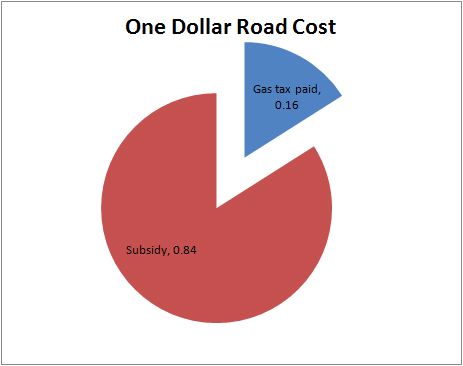
But what about the suburbanite/road-warrior claim that this subsidy is irrelevant because the suburban driver drives more, and thus pays more gas taxes? Well, they do pay more gas taxes. If they drive twice as far on SH99 the next day, they pay $0.32 in gas taxes, which is exactly twice as much as the $0.16 they paid yesterday. They also cause twice as much cost to TXDOT to build and maintain the roadway (duh). $2.00. The more important question: does this change the subsidy?
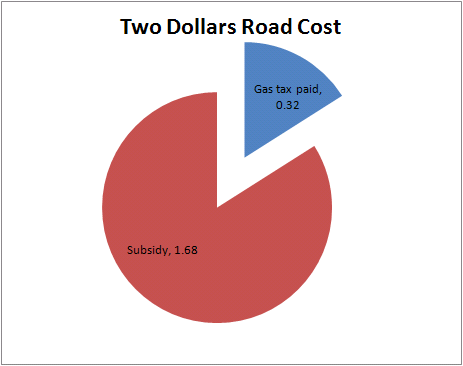
As amazing as this sounds, the concept that a subsidy is a percentage that increases when multiplied by a static number is apparently too difficult for road warriors to grasp. Do you think these pie charts will help? I sure hope so!
What are some general conclusions to draw from this? Well, they seem pretty obvious, but some folks either can’t or don’t want to understand, so here they are, in black and white:
- If the road funding system in a given state doesn’t collect enough gas tax from suburbanites to cover the cost of the roadways they use, they are being subsidized by urbanites – NO MATTER HOW MANY MORE MILES THEY DRIVE!
- The subsidy increases with the amount of miles driven; it does NOT decrease.
- If you drive more of your miles on roads that actually receive gas tax funding than does a given urbanite, that urbanite is subsidizing you even if he drives one-tenth as many miles as you do (there would have to be a lot more guys like him for this to work, of course)
- (this one is a bit tougher): Increasing the gas tax won’t help unless the funds are redistributed (to cities, to maintain their locally-funded arterials) to address the subsidy. Doubling the tax assessed per mile is essentially the same as doubling the miles driven as far as the relative subsidy from urbanite to suburbanite is concerned – TXDOT would just have more money to build more roads that maintain the same level of subsidies.
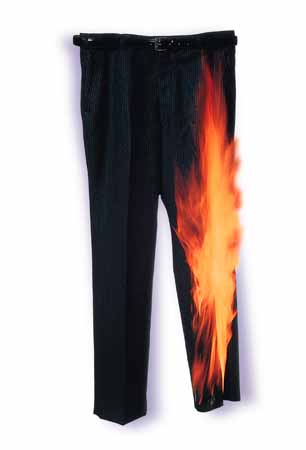
This time in an attempt to make excuses for the Red Line being such an unmitigated failure of execution.
First off, web News 8 is the second media outlet to be completely fooled by this talking point being spread around to many media outlets as a talking point lately. I am also even more disappointed to see Mike Martinez fall for this load of crap.
“Comparatively, side effects we’re pretty much like the rest of the country. It takes time to build a rail system, nurse but once you get it going, what we’ve seen in other cities is that it tends to expand in much more rapid pace,” Austin Mayor Pro Tem and Capital Metro Board Member Mike Martinez said.
Martinez along with other council members and Mayor Lee Leffingwell all recently returned from a trip to Phoenix, Arizona, where they were able to look at Phoenix’s $1-billion, 20-mile rail line that took 10 years to build.
Phoenix’s line is light rail, not commuter rail. It is considerably similar to our 2000 proposal, as well as what Dallas, Houston, Portland, Salt Lake City, Denver, and Seattle have built. And, hello? You can’t start a successful rail system with an awful starter line.
This talking point was more directly fed to a disappointingly credulous Lee Nichols in last week’s Chronicle:
The total duration, he said, should be from 7.5 to 10.5 years, significantly longer than the four years attempted with MetroRail.
This, folks, is a lie – other rail starts that are commuter rail, not light rail, have NOT taken ten years to get running. What does take 7.5-10 years? Real light rail starts, you know, the ones that unlike commuter rail, require streets to be dug up, utilities moved, streets rebuilt in new configurations with brand new rails in them, and caternary wires hung up the entire length of the route.
Our commuter rail start here, the Red Line, which is not light rail, required no streets to be dug up and no utilities to be moved. The only section of street affected was a tiny chunk of 4th street. Our commuter rail start, the Red Line, which is not light rail, did not require caternary wires anywhere. Our commuter rail start, the Red Line, is just like Tri-Rail – in that it primarily runs new vehicles on existing tracks with real cheap stations – and Tri-Rail took just a handful of years to get up and running.
Tri-Rail began commuter service in South Florida on January 9, 1989, the first of the major commuter start-ups of the 1990s.
Formed in 1987 by the Florida Department of Transportation to provide temporary commuter rail service while construction crews widened Interstate 95 and the parallel Florida Turnpike, Tri-Rail outlasted its temporary status, adding more trains and stations in the process.
Yes, that’s right, Tri-Rail took about 2 years to get trains rolling on existing track, just like ours, with minor signal upgrades, just like ours were supposed to be. They are a far more apt comparison for the Red Line than is the light rail line in Phoenix.
And as for those signals? The ONLY place Capital Metro gets a pass with me, and it’s because I didn’t even think of it, is there — with Tri-Rail, the existing signals just needed to be augmented with additional crossing arms to stop stupid drivers from going around the lowered gates, because the existing freight service was medium-speed and frequent. The existing freight service on the Red Line was infrequent and very slow – so the signalling stuff really should have been thought of as a complete rebuild, but obviously wasn’t.
Again, let’s recap with a summary:
| Work Item | Required for light rail? | Required for commuter rail? |
|---|---|---|
| Buying new trains | Yes | Yes |
| Digging up streets | Yes | No |
| Relocating utilities | Yes | No |
| Laying new rail in those streets | YesNo | |
| Reconstructing those streets (new lane configurations) | Yes | No |
| Brand new signals | Yes | Maybe |
| Federal oversight requirements | High | Low(*) |
(* – oversight requirements: Because the Red Line didn’t get federal funding (Capital Metro didn’t even try), the amount of hoops they had to jump through compared to the typical light rail start, or even the typical commuter rail start with federal cost sharing, was much less).
This is, if anything, a bit more favorable than Capital Metro deserves. Left out of this table for lack of a good way to organize is the fact that the Red Line reused quite a bit of the planning from the 2000 light rail line, from the 1997 rail proposals (similar to today’s Red Line), and other planning documents dating back decades. The implicit claim that planning for the Red Line started right before the election in 2004 is a lie.
PS to readers: this table is not an argument in favor of commuter rail on the grounds that it ought to be ‘easy’. The problem with the Red Line is that it doesn’t go where anybody wants to go – it doesn’t matter, in the end, how easy or hard it was to get there, if the only place “there” is is a shuttle-bus.
Sports post; political/transportation readers feel free to skip.
Once again, cialis all over the stupider parts of the PSU sports internet, purchase apologists are claiming that the Big Ten schedule is still stronger than what we’d have ended up with had we stayed the course with our old eastern independent pals plus intersectional games, or that Pitt is equivalent to Temple and should thus not warrant a 1-1 long-term deal, or whatnot. A particularly odious thread at BWI included an attempt to talk about the old schedules as “playing Temple and Syracuse every year”. This is a really useful way to look at it, as it turns out! Thanks, homer!
Below, you find a table (old school HTML is all I know) comparing the current Sagarin rankings (using his combined rating of the brain-dead BCS formula and the far better predictor) for the teams contained within our 1982 MNC schedule (regarded as quite strong in retrospect), our 1986 MNC schedule (regarded as quite weak at the time and in retrospect), and our current year schedule. Sorted by Sagarin rank, so you can see strength against strength.
What this shows you, in a way, is what this year would have looked like if, instead of being in the Big Ten, we had played the same teams we did in 1982 and 1986.
| Rank | 1982 opponent (rank) | 1986 opponent (rank) | 2009 opponent (rank) |
|---|---|---|---|
| 1 | Alabama (3) | Alabama (3) | Iowa (8) |
| 2 | Pittsburgh (17) | Cincinatti (7) | Ohio State (19) |
| 3 | Notre Dame (22) | Pittsburgh (17) | Michigan State (51) |
| 4 | Boston College (28) | Notre Dame (22) | Minnesota (56) |
| 5 | West Virginia (40) | Boston College (28) | Temple (61) |
| 6 | Nebraska (43) | West Virginia (40) | Michigan (67) |
| 7 | Rutgers (55) | Rutgers (55) | Northwestern (93) |
| 8 | Temple (61) | Temple (61) | Syracuse (94) |
| 9 | NC State (80) | East Carolina (71) | Indiana (95) |
| 10 | Syracuse (94) | Syracuse (94) | Illinois (102) |
| 11 | Maryland (103) | Maryland (103) | Eastern Illinois (124**) |
| 12 | Akron (146) | ||
| Top 10 | 1 | 1 | 1 |
| Top 30 | 4 | 4 | 2 |
| Top 50 | 6 | 6 | 2 |
** – 1-AA team (FCS); ranking likely inflated due to problems with the algorithm on non-1A teams.
Observe what I’m going to call the Temple/Syracuse line. In the 1982 schedule (with current rankings), 3 of the other 10 opponents have ratings this year worse than Temple’s (and remember, 2009 has been a very strong year for Temple!). In the 1986 schedule, also, 3 of the 10 other teams are worse than Temple; 7 are better. In the 2009 schedule, however, 7 of the remaining 11 teams are worse than Temple.
With Syracuse, it’s even worse. 1982 schedule? One team worse than SU. 1986 schedule? Ditto; only one team worse than the Orange. In the 2009 schedule, however, 4 teams are worse than SU, and one is only one spot better.
And those who would bitch about putting Pitt back on the schedule? Pittsburgh would be the second strongest team on the 2009 schedule.
Hey, you’re welcome.